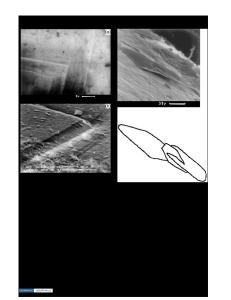An optimum heating program for fabricating MTG Bi 1.6 Pb 0.4 Sr 2 Ca 2 Cu 3 O y superconductors
- PDF / 1,230,258 Bytes
- 7 Pages / 576 x 792 pts Page_size
- 44 Downloads / 348 Views
T. F. Yu, J. C. L. Chow, and P. C. W. Fung Physics Department, The University of Hong Kong, Hong Kong (Received 16 September 1993; accepted 20 April 1994)
Following our recent report on the successful fabrication of "stationary" MTG Bii.6Pbo.4Sr2Ca2Cu303, pellets in a simple tube furnace, we have tried many heating programs with various "crystal growth starting temperatures", Ts, and sintering temperatures, Te; the samples are sintered for 20-40 h before quenching in air. It is found that Ts-Te should be rather narrow to produce good MTG samples, and the typical value of Jc is enhanced from 100 A cm" 2 (for a polycrystalline sample) to about 3 X 103 A cm" 2 for our good ones. SEM and TEM results indicate that the samples are full of packs which contain highly oriented mica-like layers.
I. INTRODUCTION There are several crucial aspects to make fabrication of the Bi-class MTG samples a success. The first technical problem one faces is the loss of sample material when the sample is heated to melt. We have to find a substrate that reacts with the melt liquids to form crystals basically of the Bi-class members at a slow rate. The "unwanted layer" can be ground off after sintering, leaving a substantial amount of desired superconducting material. We have found in our previous investigation of this project that pellet made of Sr with the same size as the sample will serve the stated purpose.1 The
second problem one faces is to find the right temperature for crystal growth to commence. Of course, the cooling temperature has to be within a (narrow) range to sustain the growth of single crystal-like layers or lumps. It is also anticipated that nuclei should exist inside the sample to help the growth process. While Y 2 BaCu0 5 is guessed to be the nuclei for the Y-123 specimens,2"6 the CaO particles are conjectured to be possibly the nuclei in the Bi-class samples, and the solid-state reaction method consists of two steps as described in Ref. 1. The MTG heating program for stationary sample(s) placed near the ends of a simple tube furnace can be
1000 "> 950 ° c lii) 180 »C/hr
900
Ts
(iv) 0.5 °C7hr
800
y
(v)T e
700 600
ratu y superconductors. J. Mater. Res., Vol. 9, No. 9, Sep 1994 http://journals.cambridge.org
Downloaded: 21 Mar 2015
2231
1994 Materials Research Society IP address: 169.230.243.252
Z. L Du etal.: An optimum heating program for fabricating MTG
TABLE I. Heating programs for Bij 6Pbo.4Sr2Ca2Cu3Oj, superconductor.
Program
T,
A B
870 880 890 900 910
C D E
850 860 870 870 870
considered to be made of six heating stages. In stage (i), the tube is heated to the maximum temperature Tm of the heating program with a rate that is not at all critical (Fig. 1). It is believed that some particles must act as nuclei for crystal growth, and one natural theory is to make Tm higher than the melting temperatures of all compounds except perhaps one. Since the melting temperature of CaO powder is 2614 °C, Tm is chosen to be 950 °C at which compounds of Bi, Sr, and Cu have already melted and CaO is the "adde
Data Loading...











